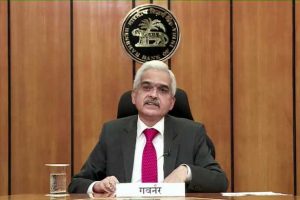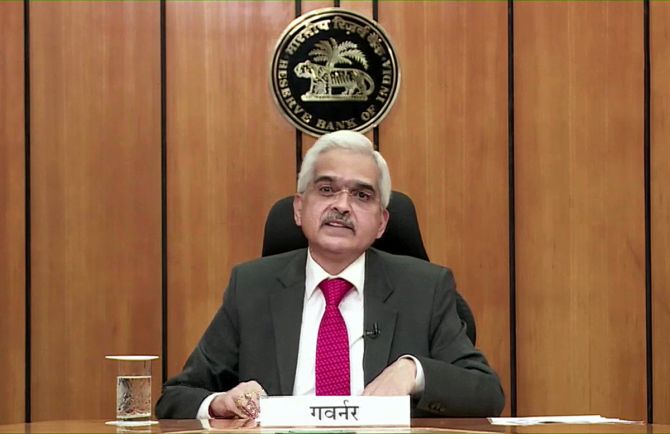‘Growth has revived in certain segments’

‘There are some high-frequency indicators where uptick is visible and some where it is not’
After announcing the monetary policy resolution, RBI Governor Shaktikanta Das and Deputy Governors Michael Debabrata Patra, Mayank Jain, M Rajeshwar Rao and T Rabi Sankar, spoke to the media on issues ranging from the withdrawal of the G-Sec acquisition programme (G-SAP) to the involvement of Big Tech in banking.
What was the reason behind not conducting any more G-SAPs?
Das: At the moment, G-SAP is not required. But going forward, G-SAP together with options of operation twist and open market operations are very much on the table.
At the moment, the total quantum that is coming under our fixed reverse repo window is Rs 4-4.5 trillion and even in the first week of December, the quantum expected under the fixed-rate reverse repo will be in the region of Rs 2-3 trillion. Therefore, it is not a steep reduction of liquidity.
As a central bank, would you like to use “surprise” as a policy tool?
Das: There was no surprise. It’s not sudden intervention. The road map, which I laid out for the 14-day variable rate reverse repo (VRRR) auctions, …it is Rs 4 trillion today, for which the notification was issued yesterday (Thursday) and every fortnight it goes up by Rs 50,000 crore ending at Rs 6 trillion in the first week of December. So, the overall approach is gradualism.
And, then the deployment of 28-day VRRR and further fine-tuning operations will depend on the evolving situation. So, I would not agree that there is a surprise in what we have done. We have given out a clear, gradual, calibrated road map.
Have the banks revealed all the stress in their portfolios? Do you feel there is a need for a regulatory road map on climate change risks?
Jain: While banks and other financial institutions have resilient capital and liquidity buffers, we have also seen that the stress has been moderate in spite of the pandemic. We are closely monitoring the build-up of stress in MSME and retail credit. And, the RBI is conducting special meetings and discussions with the top management of banks, small finance banks, and NBFCs wherever such stress build-up has been observed.
With regard to climate risk, I think it is at the nascent stage and a debate is ongoing on whether it should be in the domain of the government or the RBI. Nevertheless, we have initiated various processes to understand the dynamics of regulatory policies on climate risk.
Rao: We have recognised the issue of climate risk internally and we have joined the network of greening of financial institutions. We are also joining the various working groups set up under the aegis of NGFS. We have set up a sustainable finance group internally. The idea is to look at this issue comprehensively and come out with some kind of a guidance note in a short period of time.
Can you give us any timetable for inclusion of Indian bonds in the global indices? The cut-off for VRRR has come at 3.99%. Should we read it as a signal?
Das: This matter is in an advanced stage of discussion with the major index providers. Both the RBI and the government are in constant dialogue with the providers. There are a few issues but they are getting resolved. It should happen in the next few months.
Patra: We are essentially in a passive mode. Having offered the 14-day reverse repo auctions, we will accept what the market gives us, and thereby we will discover the price of excess reserves as indicated by the market.
What would signal to the RBI that there is a comfort to start moving away from the emergency levels because you cannot pull out this level of liquidity in a knee-jerk fashion?
Patra: We would look for signs that the recovery is getting solidly entrenched and that the inflation rate is moving in the desired direction, that is, towards the target. So, we are not looking at destinations but at journeys. Hence, even dynamic movements in these directions will be our trigger.
The RBI is following a step-wise approach. The first is the stopping of liquidity; the second is moving liquidity from fixed-rate reverse repo to the auctions. The auctions have two benefits for us: they enable better pricing of excess reserves and they give the RBI a better handle on these reserves by giving more discretion in managing liquidity.
On the next steps, let me assure you, the RBI has all the adequate instruments. The issue is not of instruments but of timing and calibrations.
We are on a resolute pause but at the same time, the MPC is saying recovery is happening, inflation is coming down. Is there some contradiction there?
Das: No, there is no contradiction at all. Developments around growth and inflation are dynamic and evolving. Going forward in a calibrated manner, without creating disruptions, our endeavour will be to get as close as possible to 4 per cent (inflation target).
And, growth has revived in certain segments. There are some high-frequency indicators where uptick is visible and some where it is not. We are looking at growth signs to become entrenched and show signs of durability.
The RBI is an inflation-targeting body. But in the last one and half years, we have been dealing with an extraordinary situation that needed innovative and unconventional measures.
Our approach will be gradualism. We do not want to rock the boat, more so, because we have to reach the shore, which is visible and there is a journey beyond the shores.
You have mentioned that there is a need for calibration of indirect taxes on fuel. But, there has been no movement on this from the government’s side…
Das: On this issue and several others where the action lies in the domain of the government, there is constant engagement between the government and the RBI. We voice all our suggestions and concerns from time to time.
The government has taken several measures with regard to pulses, edible oil, and other supply-side factors. On the petrol-diesel front, we have flagged the issues, now it is for the government to consider all aspects and make a decision.
Banks like SBI have been complaining about mispricing of credit risks due to excess liquidity and lack of credit growth. Is this a worrying trend?
Das: I do not think SBI has flagged this as a complaint. They have flagged it as a concern, which is for banks to note.
Whatever be the liquidity situation, it is for the banks to do their risk assessment and price loans accordingly. So, the action lies in the domain of the banks.
Is RBI comfortable in allowing tech giants to give their front-end platform to market liabilities products?
Rao: The entry of Big Tech into the financial sector is a global phenomenon, which is engaging the attention of central banks around the world. We are also examining the issue from a regulatory implications standpoint.
Penalty on ATMs for downtime has resulted in some banks closing ATMs. What is the resolution to this problem?
Sankar: The idea behind the penalty was to ensure that ATMs are available in areas where the attention to ATMs is less. We have received mixed feedback. We are trying to have a review and see how best it can be implemented.
But ensuring that money is available is what made us issue the circular.
Source: Read Full Article

